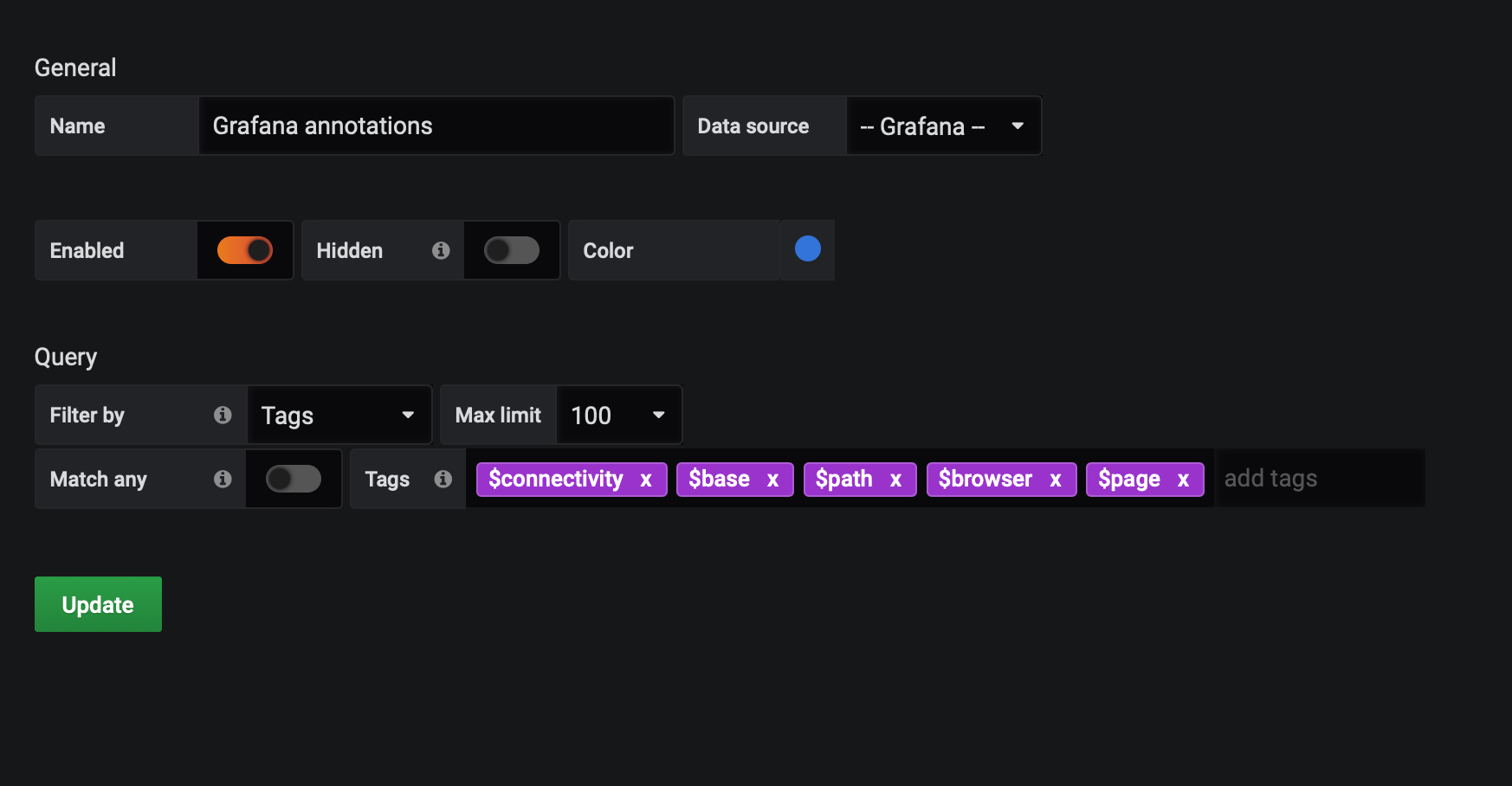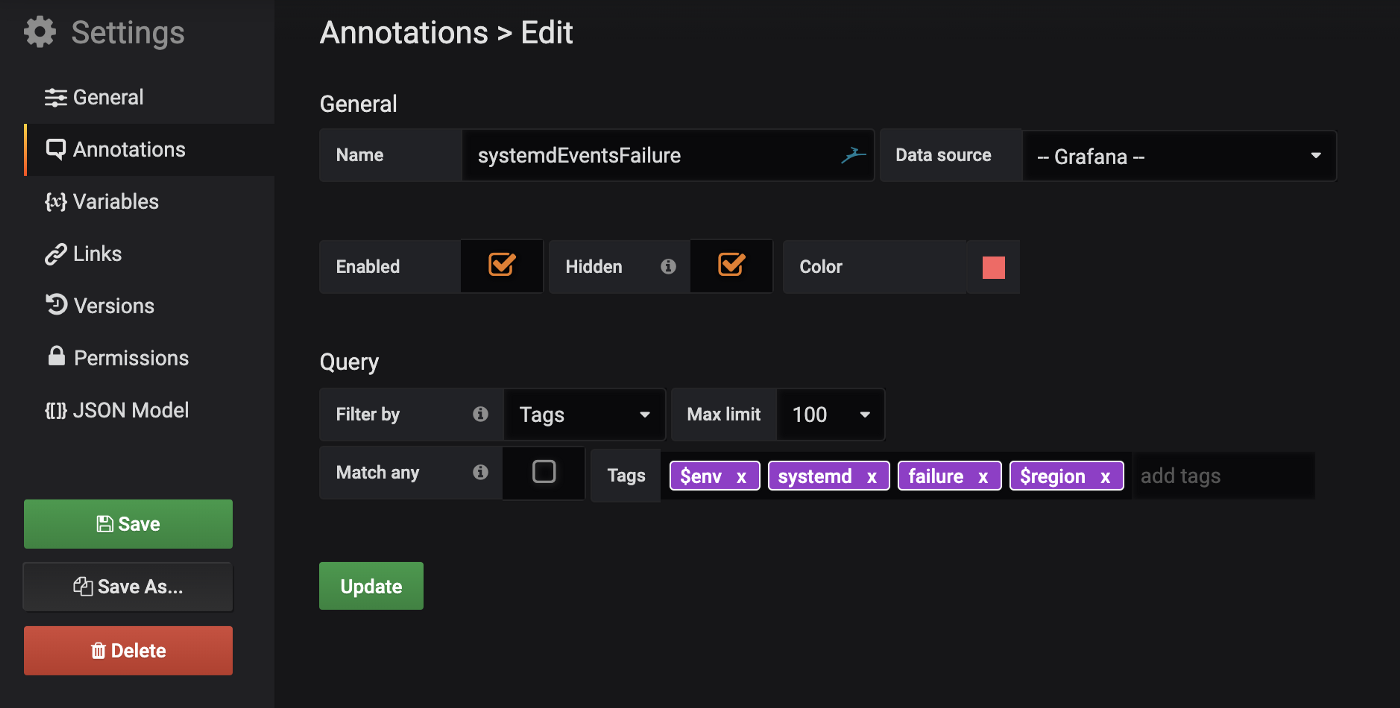

- #Grafana annotations influxdb trial#
- #Grafana annotations influxdb series#
Grafana is an open-source analytics and monitoring solution developed and supported by Grafana Labs.
#Grafana annotations influxdb trial#
If you want to try out Grafana, head to MetricFire's free trial of Hosted Grafana. In this article, we compare their features and highlight their differences in terms of dashboards and help you make the right choice.įor more details on other features and instructions, read our blog here. However, selecting the best is never easy. Both of them provide innovative dashboarding features. Grafana and Chronograf both are among the best tools available today. In our blogs at Metricfire, we break down the best tools in terms of their setup efforts, usage, market competitors, pricing models, best practices, and many more. Considering the plethora of graphing tools available in the market today, selecting the right one could often be confusing. Visualization and Analytics are two of the most important aspects of monitoring without which the entire data stack could just mean NOTHING.
Differences Between Grafana and Chronograf in Terms of Dashboards:. Set the color used to show exemplar data. A histogram represents the distribution of the bucket values for a specific timestamp.Ĭhoose whether you want to display the heatmap legend on the visualization. Show Histogram - Show a Y-axis histogram on the tooltip. Use these settings to refine your visualization. #Grafana annotations influxdb series#
The series max value is the default value. If the bucket value is greater than Max, then it is mapped to the “maximum” color.
End - Maximum value using for cell color calculation. 
The series min value is the default value. If the bucket value is less than Min, then it is mapped to the “minimum” color. Start - Minimum value using for cell color calculation.Consider a bucket value as a Z-axis and Min and Max as Z-Min and Z-Max, respectively. With Min and Max you can overwrite those values.
 Exponent - value of the exponent, greater than 0.īy default, Grafana calculates cell colors based on minimum and maximum bucket values. In case of 1, scale will be the same as linear. If exponent is greater than 1, you will get an exponential scale. If exponent is less than 1, you will get a logarithmic scale. Cell opacity calculated as value ^ k, where k is a configured Exponent value. Bucket value maps linearly to the opacity. Scale - Scale for mapping bucket values to the opacity. opacity - Bucket value represented by cell opacity. Scheme - If the mode is scheme, then select a color scheme. Scheme - Bucket value represented by cell color. In this case, the color will not change but the amount of opacity will change with the bucket count You can also change the color mode to Opacity. Some color schemes are automatically inverted when using the light theme. The leftmost color on the spectrum represents the minimum count and the color on the right most side represents the maximum count. The color spectrum controls the mapping between value count (in each bucket) and the color assigned to each bucket. When selected, the axis appears in reverse order. This setting configures the width for the axis. This setting determines decimal configuration. log (base 10) - Logarithmic scale with base 10.ĭefines how the Y axis is displayed Placement. log (base 2) - Logarithmic scale with base 2. Select one of the following Y-axis value scales: This setting determines how the Y-axis is split into buckets. For example, a time range of 1h makes the cells 1-hour wide on the X-axis. You can specify a time interval in the Size input. This setting determines how the X-axis is split into buckets. This setting determines if the data is already a calculated heatmap (from the data source/transformer), or one that should be For more information about histograms, refer to Introduction to histograms and heatmaps. The Heatmap panel visualization allows you to view histograms over time. Grafana Cloud Enterprise Open source Heatmap
Exponent - value of the exponent, greater than 0.īy default, Grafana calculates cell colors based on minimum and maximum bucket values. In case of 1, scale will be the same as linear. If exponent is greater than 1, you will get an exponential scale. If exponent is less than 1, you will get a logarithmic scale. Cell opacity calculated as value ^ k, where k is a configured Exponent value. Bucket value maps linearly to the opacity. Scale - Scale for mapping bucket values to the opacity. opacity - Bucket value represented by cell opacity. Scheme - If the mode is scheme, then select a color scheme. Scheme - Bucket value represented by cell color. In this case, the color will not change but the amount of opacity will change with the bucket count You can also change the color mode to Opacity. Some color schemes are automatically inverted when using the light theme. The leftmost color on the spectrum represents the minimum count and the color on the right most side represents the maximum count. The color spectrum controls the mapping between value count (in each bucket) and the color assigned to each bucket. When selected, the axis appears in reverse order. This setting configures the width for the axis. This setting determines decimal configuration. log (base 10) - Logarithmic scale with base 10.ĭefines how the Y axis is displayed Placement. log (base 2) - Logarithmic scale with base 2. Select one of the following Y-axis value scales: This setting determines how the Y-axis is split into buckets. For example, a time range of 1h makes the cells 1-hour wide on the X-axis. You can specify a time interval in the Size input. This setting determines how the X-axis is split into buckets. This setting determines if the data is already a calculated heatmap (from the data source/transformer), or one that should be For more information about histograms, refer to Introduction to histograms and heatmaps. The Heatmap panel visualization allows you to view histograms over time. Grafana Cloud Enterprise Open source Heatmap







 0 kommentar(er)
0 kommentar(er)
